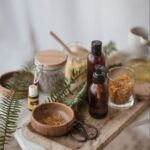Memories of the Healing Fat.
Growing up nearly every home had a glass jar of sheep tallow tucked away in the kitchen cabinet. It wasn’t just for cooking, it was medicine. I remember how our mothers and grandmothers would slowly render fat from a sheep’s tail, strain it into golden oil and store it carefully. The crispy bits left behind “cracklings”, were our crunchy treat sprinkled with salt.
When fever struck or a stubborn cough refused to ease, two warm spoonfuls of tallow were administered almost like a prescription. For acne, rashes or insect bite, it was dabbed directly onto the skin. Some even added it to porridge or greens, not only for flavor but for strength and nourishment. In those days, sheep tallow was considered nature’s antibiotic and we were even warned not to mix it with modern antibiotics.
It wasn’t just sheep. Duck or chicken fat was warmed and used as ear drops for earache. Every fat from the domestic animals reared had a place in healing or food. Then came the shift.
How Tallow Was Forgotten
When home slaughtering gave way to slaughter houses and industrial butchering, tallow began to disappear. Butchers trimmed off the fat, health campaigns demonized animal fats and seed oils branded themselves as the lighter and “healthier” choice. Salad oils, as we called them became the in thing and tallow was dismissed as heavy, old-fashioned, smelly and unhealthy.
Today, as science advances and people search for natural nutrient-dense foods, tallow is making a remarkable comeback. And this time it’s not just nostalgia, it’s science and wellness driving the revival.
Properties of Tallow: Why it is good for you
Vitamins A, D, E, and K:
Keeps your immune system strong, supports glowing skin, helps balance your hormones and slows down visible signs of ageing.
Conjugated Linoleic Acid (CLA):
Helps your body burn fat more efficiently and calms inflammation.
Stearic and Oleic Acids:
Feeds your gut with healthy support and keep your skin soft and resilient.
Stable Saturated Fats:
Give you steady, long-lasting energy and don’t easily spoil like many seed oils.
The above qualities make tallow a unique dual-purpose oil: Safe for high-heat cooking while also deeply nourishing for your skin.
Day to day Practical Usage for Tallow: From Kitchen to the Beauty Industry.
- In the Kitchen
Tallow is stable and has with high smoke point for frying, sautéing or roasting, unlike refined seed oils that oxidize quickly. It imparts a rich flavor to vegetables, meats or even baked goods. For those on keto, paleo or traditional diets, tallow is a prized fat that fuels energy and supports metabolism. - In Skincare and Beauty
Tallow is almost bio-identical to the oils our skin produces. This is why tallow balms, creams and soaps are trending in natural beauty circles. Besides claims of healing dry skin, eczema and dermatitis, they work as deep moisturising body butter and balms for lips and hands. Tallow creates luxurious soaps with creamy lather and long-lasting bars. It is a great alternative to petroleum based products. - In Natural Remedies
From chest rubs for colds, abrasions, scalds to scalp treatments for dandruff, tallow has returned as a multi-purpose household remedy, now backed by both tested traditions and modern holistic health movements.
Rendering Tallow at Home and Commercial Production.
At home, rendering tallow is simple:
Chop clean fat trimmings, heat slowly until the oil separates, strain and store in glass jars. No refrigeration is required.
Sheep tail fat is especially prized for its clean and mild taste.
Commercially, the opportunity is enormous. Entrepreneurs are now sourcing grass-fed fat, rendering it, testing for purity and packaging it in eco-friendly jars, tins or tubes. Healthpreneurs are keen on authentic tallow-based wellness products as consumers seek clean-label alternatives.
The value chain stretches from farmers and butchers to skincare formulators and artisanal soap makers, meaning local economies can benefit as much as global markets.
Other Rendered Fats in the Spotlight
Ghee: Clarified butter with deep Ayurvedic roots.
Duck fat: Loved by chefs for its gourmet touch.
Lard (pork fat): Historically common, though less used in certain cultures
Chicken fat (schmaltz): Prized in Jewish cooking
Each has its place, but tallow stands out as nutrient-dense, versatile and shelf-stable fat.
A Business and Wellness Renaissance
Today, we are witnessing a fascinating shift. What was once dismissed as an old-fashioned cooking fat is now celebrated in natural health stores, clean beauty brands, keto markets and even farm-to-skin product lines. For entrepreneurs tallow is more than a product. It’s a story of tradition, wellness and sustainability coming full circle with viable commercial opportunities. For families it’s a return to something simple, affordable and with undeniable health benefits.
It is proof that sometimes the future of health is hidden in the wisdom of the past.







